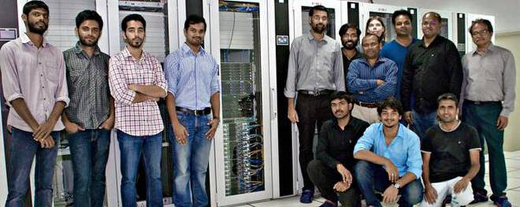Nobel boost to Bengaluru’s link to LIGO
Mangalore Today News Network
Oct 06, 2017: As Rainer Weiss, Barry C. Barish and Kip S. Thorne take the stage later this year to accept the Nobel Prize for Physics, they will be standing on the shoulders of hundreds of collaborators from across the world, who collectively made it possible to sense gravitational waves that “shook the world” in 2016.

Of these, more than 35 scientists from India, including a team of seven from Bengaluru-based International Centre for Theoretical Sciences (ICTS), played a significant role in understanding and deciphering the data from the Laser Interferometer Gravitational-wave Observatory (LIGO), an international collaboration pioneered by the three Nobel laureates.
At Hessarghatta, the seven-member team — led by Parameswaran Ajith from ICTS — works on modelling the sources of gravitational waves, among others; their LIGO Tier-3 grid computing centre tests Einstein’s famous Theory of Relativity with the data thrown up by the detectors in the U.S. and Europe. “The laureates associate themselves with the LIGO/Virgo collaboration rather than their individual academic institutions. They have even said the award would be received on behalf of the collaborators. It’s heartening to see this,” says Dr. Ajith.
The team, after all, finds a place amongst the thousand authors, including the three laureates, of the paper ‘Observation of Gravitational Waves from a Binary Black Hole Merger’, which announced the experimental proof of gravitational waves in 2016.
India and LIGO
Indian scientists have a long, often unacknowledged presence in the fledgling field. For instance, the works of C. V. Vishveshwara, who died in the city earlier this year, in the 1970s continues to remain highly relevant.
And, it is perhaps these initial forays that has seen India do better in this field of research than others. “A few decades ago, it was just two of us in gravitational waves,” says Bala Iyer, chairperson of IndIGO (Indian Initiative in Gravitational-wave Observations) consortium and also associated with ICTS. “Now, there is a community of over 200 and we are struggling to keep up with the interest.”
With the ₹1,500-crore Indian LIGO detector expected to be operational by 2024, India is expected to play a key role in utilising the discovery that many scientists say is bigger than X-ray or microwave radiation that gave unparalleled views of the universe.
Courtesy: The hindu
- Change in train services due to track maintenance works
- Hot and humid conditions likely to prevail till Saturday in coastal districts
- Kundapur: Boat goes off track as fishermen doze off
- Mangalore University hostel students protest against poor quality food
- Bonda factory gets clean chit in alleged food poisoning case
- Businessman succumbs to cardiac arrest while travelling in bus
- 123 couples tie the knot at mass marriage in Dharmasthala
- Mangaluru: CCB arrests two, seizes MDMA worth Rs 9 lakh
- Mangaluru :On May Day, TTEs stage protest at Central Railway station.
- Uppinangady: Woman missing with one year old daughter
- WhatsApp will soon block you from chatting temporarily if users violate its rules: All details
- Nasir murder case: Court sentences four convicts to life imprisonment
- Belthangady: Web cam stolen from polling booth at Thekkar
- Prajwal Revvanna’s driver who leaked sex tapes goes missing
- Modi should apoligise to all womens for helping ’mass rapist’ Prajwal fly to Germany - Rahul
- Virat Kohli fan waves RCB jersey during her graduation at US University. Watch
- Dubai hit by heavy rain again, flights hit, Abu Dhabi waterlogged
- PM Modi’s photo removed from CoWIN certificates due to model code of conduct
- Lookout notice issued against Prajwal Revanna over sex harassment videos
- Playback singer Uma Ramanan dies in Chennai
- Amid sex harassment charge, BJP’s Brij Bhushan, may be chosen in Polls
- Google lays off 200 ’core’ team employees, to shift jobs to India, Mexico: Report
- PM Modi’s 3rd term will eliminate terrorism from country: Amit Shah
- Heatwave red alert in six Karnataka districts as temperatures may cross 46 degrees Celsius
- Hindu marriage not valid unless performed with requisite ceremonies: SC
- New residential complex for the judges inaugurated in Mangaluru
- Absconding accused nabbed after 8 years
- Truck with cylinders turns turtle in Beltangady
- Bhoota Kola artist dies of cardiac arrest
- Development of the country should be our goal: Ganesh Karnik
- Container truck gets stuck under Modankap railway bridge
- Truck crushes bike’s pillion rider near BC Road
- Head constable dies of heart attack
- Udupi: PDO dismissed over financial irregularities
- CREDAI to resume Skill Development Program for Construction Workers in Mangaluru
- John B Monteiro elected president of Rachana Catholic Chamber of Commerce & Industry
- Sudhanshu Rai elected district president of All College Student Association
- Chief Minister to visit Mangaluru, Udupi on August 1
- Nitte University awards PhD degree to Tina Sheetal D’Souza
- Sachitha Nandagopal honoured by CMTAI for Community Service
- CITY INFORMATION
- TRAVEL
- TOURIST INFORMATION
- HEALTH CARE
- MISCELLANEOUS




 Write Comment
Write Comment E-Mail To a Friend
E-Mail To a Friend Facebook
Facebook Twitter
Twitter  Print
Print 

